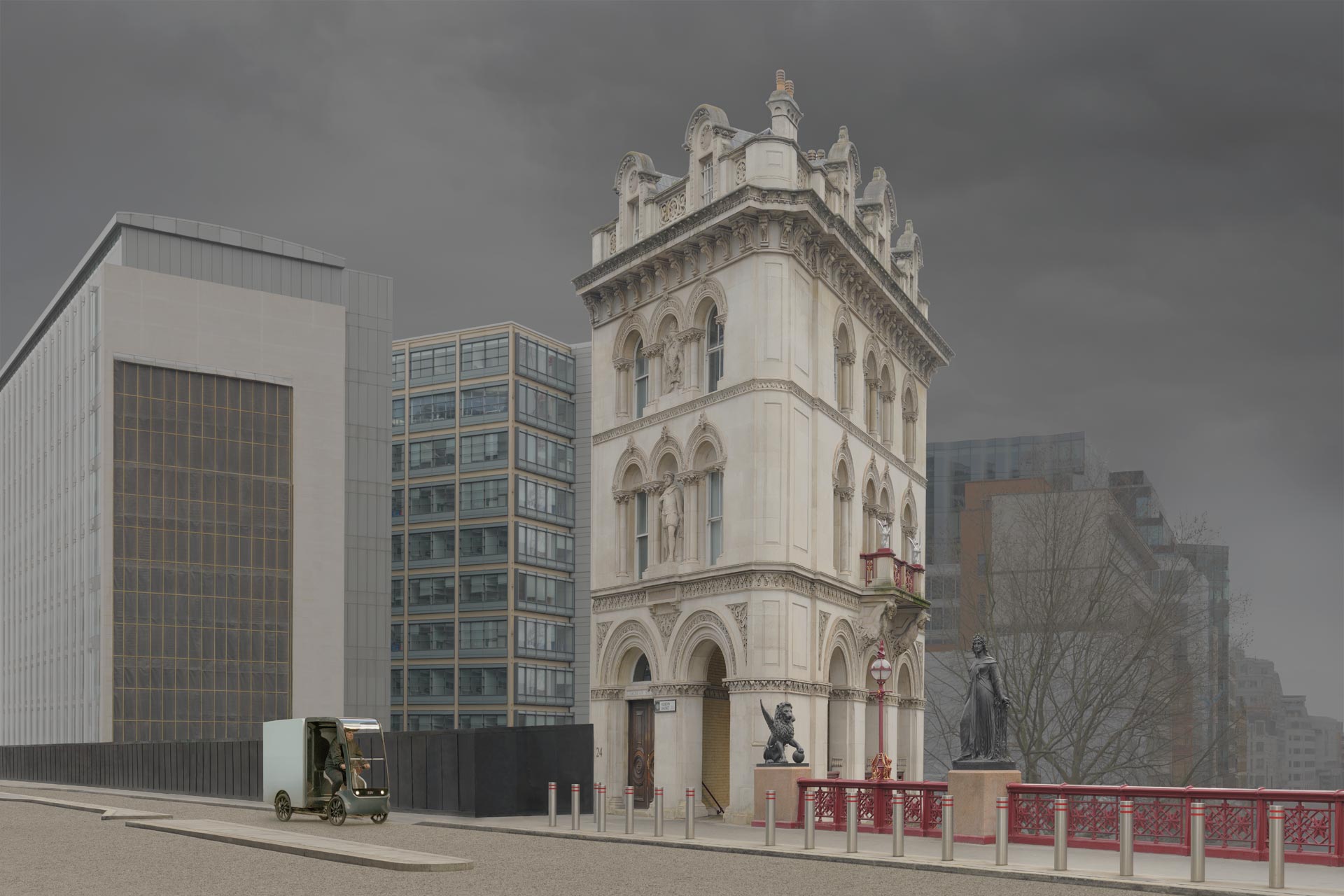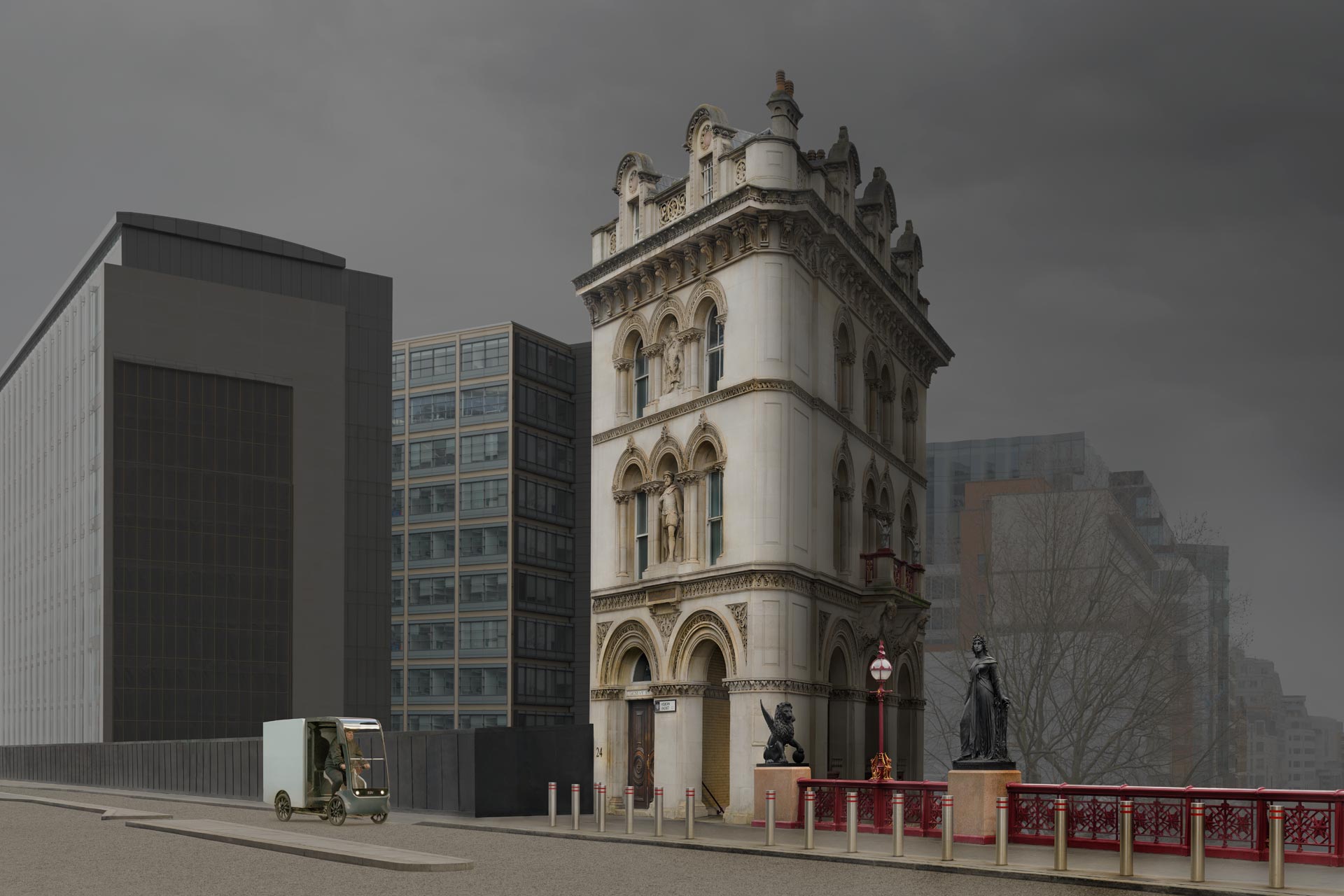David Osborn Photography. London. 2024.
The Making Of …
24 Holborn Viaduct, London.
24 Holborn Viaduct, London. – Before & After Image.
24 Holborn Viaduct, London.
24 Holborn Viaduct, London.
When we travel, our time is limited, and conditions are rarely perfect and we can only shoot what we’re given in the time we’re given. We see a subject that appeals to us, but it’s not an appealing photograph ‘as is.’ As a painter, we could include ‘what we want.’ Cameras include everything they see, but ‘everything’ can ruin our ideal photograph; cameras are unforgiving. Very few photographs are perfect straight from the camera, but that is not to say they can’t still be transformed into a good picture. – What do you do? – This is an excellent example of that problem: a good subject, but not a good photograph taken straight from the camera.
Photoshop removes the total reliance on the camera. – If we embrace Photoshop, it gives us the freedom to create like painters. The argument is not about whether we need to retouch but how well we retouch. To retouch with quality, we must draw on our knowledge beyond Photography. Understand ‘Human Nature’ to know ‘How pictures work’ and artistic expertise to ‘Create pictures that work.’ The key is to transform our photograph and make it a thought-provoking image. – This is where the enjoyment of artistic interpretation comes in, sparking the viewer’s curiosity and imagination, then creative satisfaction for ourselves.
I was in central London and walked past this old building, 24 Holborn Viaduct. – I had seen it many times before, but this time, it was different. It felt alone and isolated. The tower block beside it had been demolished. Its lonely, defiant, and timeless attitude struck me; it said to me, ‘I’ve been here for many years, I’m not moving. – London can modernize, I’m not.’
David Osborn Photography
Taking The Photograph.
The raw image is stitched together.
I returned the next day to photograph it using a Nikon D850 with a 35mm Sigma Art lens and a Novoflex multi-row Pano head and tripod. I chose a panoramic process to minimize the bad distortion a wide-angle lens would give me, and I can correct the architectural verticals using PTGui Panoramic stitching software. I didn’t know what to do with it as a picture, but I loved the architecture of the tall, slim, and elegant building. It had lots of old character. – However, the background buildings were ugly. The priority was to get a clean shot of the building and worry about what to do with the photograph when I returned home. All I could do now was record what I saw. It needed some life, so I shot numerous people walking, cars, buses, taxis, and as much variety as possible. The more variety, the more creative choices had.
When I played with the image in Photoshop at home, it had a strange, timeless quality, which I liked. However, adding people, cars, taxis, etc., gave the photograph life, but it also gave it a boring everyday normality; it lost its strangeness and didn’t spark my imagination or curiosity. So, the following day, I returned again with only a Nikon and 85mm lens handheld and stood in the same position to photograph passing people and vehicles. I didn’t know what I hoped to get; I just hoped something would catch my eye. After an hour and a half, this cute electric delivery vehicle crossed the bridge. It had the same strange feel that matched the feel of my picture. – I knew this was it, so I shot it as it went by, about 5 frames, the only one to pass by.
David Osborn Photography
Creating The Picture.
After cleaning and adding the vehicle.
The first phase of the picture-making process was simplifying the picture and remove all the clutter. I did my best when composing the building, keeping clean outlines and maintaining a balanced relationship with the background buildings. – In Photoshop, I simplified the picture even more by removing all distractions that were impossible to remove when shooting. The signage and lamps on the building hoarding, for example. The general ‘noise’ or visual clutter that distracts our attention. – The more I removed, the simpler and more strange the picture felt; it lost some of its literal feel. The electric delivery vehicle was cut out by making a mask in Photoshop and then repositioned on the road to perfectly match the composition.
So, as an experiment, I thought about what would happen if I took the cleaning phase to the extreme. Not only remove distractions but to go crazy and remove everything possible, way beyond a natural level, all the expected points of reference – lamp posts, road markings, and signage. The more I removed, the more it took on a surreal feel I liked. I had disconnected the building from the feel of a literal view of reality. This meant copying a large area of a building to a new layer and then moving that layer to cover any large distracting objects like the base of the buildings behind the hoarding; these objects are too big to use the clone stamp tool.
Isolate my ‘hero ’ building.
Phase two was ’emphasis.’ – Making my ‘hero’ building stand out from the background. Make the ‘hero’ visually different to catch your eye and give it importance. – My building is brighter with more tonal contrast and detail, which contrasts with the flat, darker background, which is smoother and gentler tonally. Rebalancing the tonal relationships degrades the dominance of the background while increasing the dominance of the ‘hero.’ This gives the picture overall cohesiveness, visual readability, structure and order. The picture content has visual hierarchy, removing any confusion and indecision by the viewer about what the ‘hero’ of the picture is. This part of the process required making very accurate Photoshop masks to cut out selective buildings or areas so that their tones could be selectively altered using blending modes and adjustment layers but not leaving any telltale artefacts that would ruin the picture quality.
Make the ‘hero’ building more three-dimensional.
Having downplayed the background, giving viewers no incentive to study these areas – now it’s time to turn up the volume and bring the ‘hero’ to life. Make my ‘hero’ more dynamic then ‘Pop.’ Light dictates form. Light and three-dimensional form bring the building to life, giving it a solid structure and realism. – The cute vehicle and buildings having the same light confirm a single cohesive story about that light. Flat light also sets the mood and the picture’s timeless, surreal tone. To give my ‘hero’ more ‘Pop,’ it has been ‘dodged and burned’ to give the details more contrast. – I always do this on a duplicate layer, so I have a backup if I make mistakes or don’t like the end result. The actual ‘dodge and burn’ is just a case of carefully brushing all the details and changing the brush size relative to the size of the detail being worked on.
Increase the textural details of the building.
I changed the overall color cast to a greenish tint using a green ‘photo filter’ and adjusting its strength; green adds a more ‘eerie’ feeling, enhancing the surreal and unreal atmosphere. The final step was to give the viewer a doorway into the picture so they enter fast and efficiently without confusion or indecision; my ‘hero’ needs its own ‘hero,’ its own visual ‘eye-catcher,’ a point of visual interest clear to all which grabs the viewers attention and tells them where to start looking within the building, and where to begin their journey to explore the picture as a whole; the picture needs one clear, defined visual ‘target.’ – A strong ‘visual anomaly.’
Add the eye-catching doorway light.
Human perception dictates that our eyes are drawn to brighter tones, higher-contrast edges, and strong saturated colors; using this knowledge, I built up the interior lights in the stairway leading down to the road below. Due to its brightness and difference in the color, the orange glow makes an eye-catching ‘target’ for the viewer to enter the photograph and also triggers the viewers’ curiosity to ponder what the steps lead down to at the same time. – This is done with a solid color adjustment layer set to color blending mode to add the color and adjusting a hue/saturation adjustment layer to locally saturate the orange stair lights. – However, if we oversaturate a color, we can lose the structural detail; it takes on a ‘bald’ look. I darkened the top of the building to emphasize and concentrate attention on the brighter staircase below using a combination of layers in blending modes, adjustment layers and gradients.
David Osborn Photography
The Actionable Takeaway.
Building detail.
Creative satisfaction comes from the curiosity of not knowing what the final photograph will look like but discovering its potential while you work on the photograph and see it transform before your eyes into something totally different. – We make the pictures our own by adding our personality and ideas; it is a creative process. We use the subject only as the raw material. Retouching allows us to ‘interpret what the camera gives us,’ not rely solely on the camera to give us a literal picture. – Fluency in Photoshop gives us the creative freedom painters have.
Literal photographs don’t trigger our curiosity or imagination because they show us what we expect to see and have seen before; they offer nothing new or different. To trigger curiosity and create engaging pictures, we must show less predictable and more unexpected pictures. The result has the feel of a minimalist painting but all the detail of Photography. The sense of light, form, and atmospheric distance make it believable and understandable, and the artistic interpretation triggers curiosity and imagination, making it thought-provoking. – We may not ‘like’ a photograph, but it should ‘stimulate’ us. If a photograph stimulates us, we can call it ‘a good photograph’ because the purpose of a photograph is to stimulate the viewer.
Building detail.
We may have many beautiful pictures on file; we just don’t realize we have them because we have yet to artistically transform them to realize their full creative potential. – When we take pictures, we must judge the subject not as we see it but by ‘what it could become.’ Visualize its artistic and creative potential. – This is the enjoyable creative satisfaction of Photography: not relying on what the camera provides but using what our cameras provide as the starting point for personal artistic creativity back at home. Photography doesn’t have to be limited to recording the world. It’s very unlikely what we see will be a perfect photograph. Still, we can create stunning artistic photographs by applying our own personal creativity. This is the most enjoyable aspect of Photography for me: discovering beautiful pictures by creating engaging pictures back home after travelling. – For me, it is the purpose of travelling overseas.
This story has been published in: “Luminous Landscape”
David Osborn Photography
Let’s Talk …
Let’s chat live on a Zoom call first, free of charge, and answer any questions or concerns you may have before making a booking or payment. Just email me, and we’ll arrange a date to talk in person.
David@DavidOsbornPhotography.com
David Osborn Photography
69 Grange Gardens, Southgate,
London N14 6QN, England.
UK +44 (0) 771 204 5126









